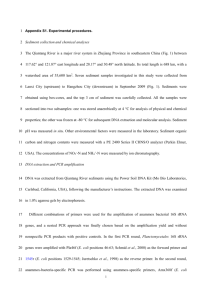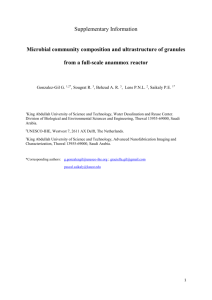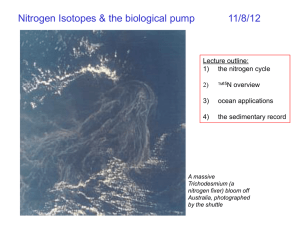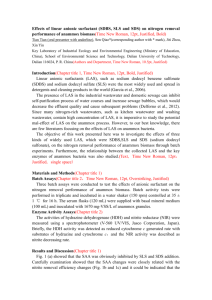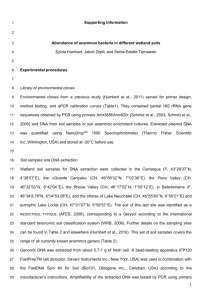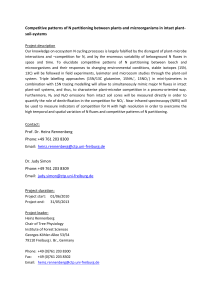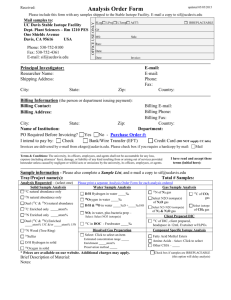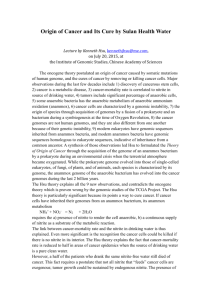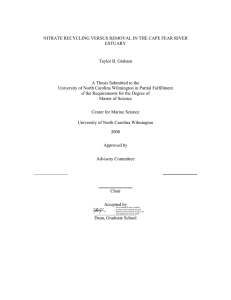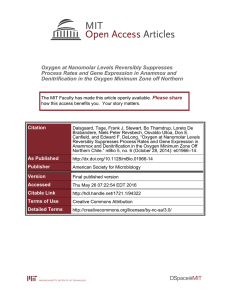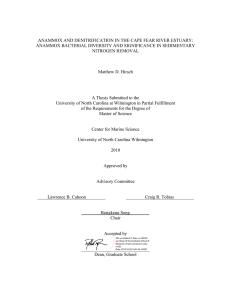Supplementary Information (doc 100K)
advertisement
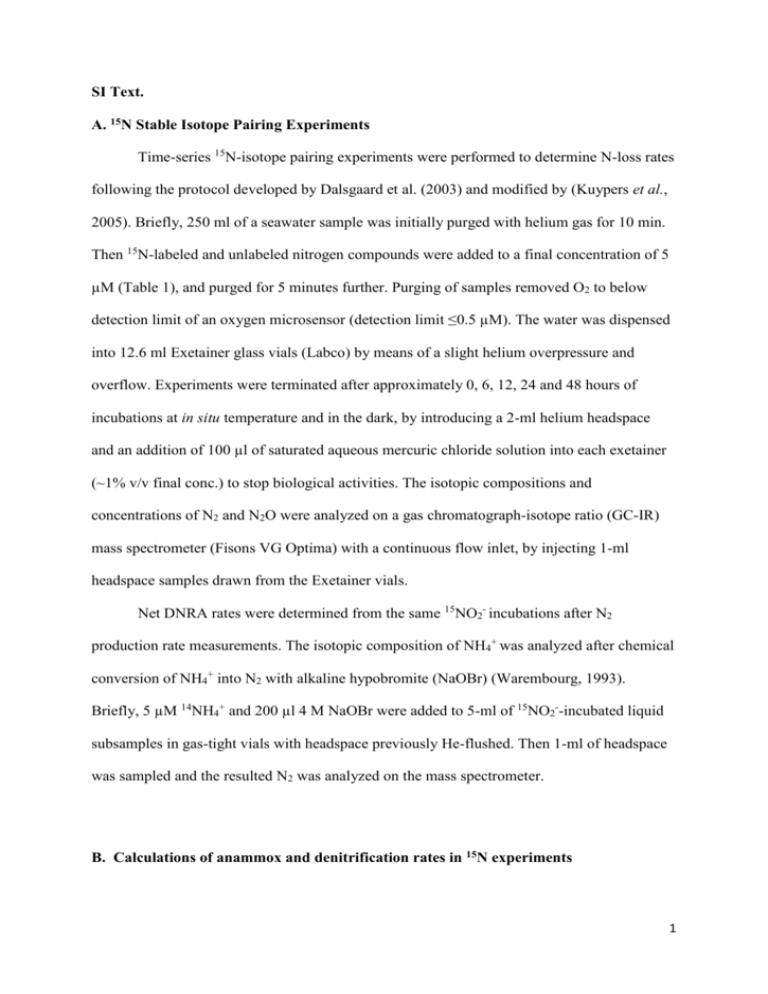
SI Text. A. 15N Stable Isotope Pairing Experiments Time-series 15N-isotope pairing experiments were performed to determine N-loss rates following the protocol developed by Dalsgaard et al. (2003) and modified by (Kuypers et al., 2005). Briefly, 250 ml of a seawater sample was initially purged with helium gas for 10 min. Then 15N-labeled and unlabeled nitrogen compounds were added to a final concentration of 5 µM (Table 1), and purged for 5 minutes further. Purging of samples removed O2 to below detection limit of an oxygen microsensor (detection limit ≤0.5 µM). The water was dispensed into 12.6 ml Exetainer glass vials (Labco) by means of a slight helium overpressure and overflow. Experiments were terminated after approximately 0, 6, 12, 24 and 48 hours of incubations at in situ temperature and in the dark, by introducing a 2-ml helium headspace and an addition of 100 µl of saturated aqueous mercuric chloride solution into each exetainer (~1% v/v final conc.) to stop biological activities. The isotopic compositions and concentrations of N2 and N2O were analyzed on a gas chromatograph-isotope ratio (GC-IR) mass spectrometer (Fisons VG Optima) with a continuous flow inlet, by injecting 1-ml headspace samples drawn from the Exetainer vials. Net DNRA rates were determined from the same 15NO2- incubations after N2 production rate measurements. The isotopic composition of NH4+ was analyzed after chemical conversion of NH4+ into N2 with alkaline hypobromite (NaOBr) (Warembourg, 1993). Briefly, 5 µM 14NH4+ and 200 µl 4 M NaOBr were added to 5-ml of 15NO2--incubated liquid subsamples in gas-tight vials with headspace previously He-flushed. Then 1-ml of headspace was sampled and the resulted N2 was analyzed on the mass spectrometer. B. Calculations of anammox and denitrification rates in 15N experiments 1 Production rates of N2 through anammox and denitrification was calculated from the excess concentrations of 14N15N and 15N15N, and the mole fractions of 15N-label in the NH4+ and NO2- pools (Fx) (Thamdrup and Dalsgaard, 2000; Thamdrup and Dalsgaard, 2002). The resultant 15N-mole fractions were ≥56% for NO2- and ≥97% for NH4+, as estimated from the concentrations before and after additions. Thus, for incubations with 15NH4+, 1 A14N 15N Fammonium (Eq. 1) where A denotes the production of N2 through anammox and Fammonium is the 15N-mole fraction in the NH4+ pool. For incubations with 15NO2-, 2 D 15N 15N Fnitrite (Eq. 2) 1 A14N 15N Fnitrite D 2 1 Fnitrite (Eq. 3) where D denotes the production of N2 through denitrification and Fnitrite is the 15N-mole fraction in the NO2- pool. This calculation assumes that denitrification is the sole source of 15 N15N and that anammox produces only 14N14N and 14N15N through random pairing of one molecule from each of the NH4+ and NO2- pools (Thamdrup and Dalsgaard, 2002). In a few incubations with 15NO2- on the Omani shelf, we observed a parallel production of 15N15N and 15NH4+ (Fig. 2 and 3). The 15N15N production could be explained by a coupling of the reduction of 15NO2- to 15NH4+ through dissimilatory nitrite reduction to ammonium (DNRA), followed by a one-to-one pairing of 15NH4+ and 15NO2- by anammox (Fig. S1). In this case, Eq. 3 is not sufficient for the calculation of anammox rates since 14 N15N may be produced from either the pairing between the added 15NO2- and ambient 14 NH4+, or that between ambient 14NO2- and the 15NH4+ produced by DNRA. In addition, 15 N15N may also be produced from the pairing between the added 15NO2- and the 15NH4+ generated through DNRA. In other words, to calculate total anammox rates, it is necessary to 2 take into account the mole fraction of 15N in the NH4+ pool (Fammonium) originating from the added 15NO2-. Total anammox rates from the 15NO2- incubations are then derived from the accumulation of both 14N15N and 15N15N following Eq. 4 and 5, 14 N 15N A Fnitrite 1 Fammonium 1 Fnitrite Fammonium (Eq. 4) 15 N 15N A Fnitrite Fammonium (Eq. 5) It follows from Eq. 5 that Fammonium 15 N 15N A Fnitrite (Eq. 6) And, by substituting Fammonium in Eq. 4 with Eq. 6 and rearranging, total anammox rates (A) can be calculated as: 15 N 15N 1 Fnitrite A 14 N 15N 215 N 15N F nitrite (Eq. 7) The calculation of A based on Eq. 7 assumes that NH4+ is produced and liberated outside the cells of the DNRA-capable bacteria and Fammonium is constant during the whole incubation, while denitrification activity is assumed negligible. The estimated 15N% of NH4+ (Fammonium) (Eq. 6) can also be viewed as an estimate for the proportion of anammox fueled by DNRA. C. Detailed Proctocols for Molecular Ecological Analyses a. CARD-FISH Seawater samples for cell enumeration were collected from Niskin bottles and fixed immediately with paraformaldehyde (1% final concentration, filtered through 0.2 µm-poresized filters) at 4°C. After 10-12 hours, 50-150 ml replicates were filtered on to polycarbonate membrane filters (0.22 µm pore-size, 47 mm diameter, GTTP, Millipore) under low vacuum, rinsed with 0.2 µm-filtered deionized water, air-dried and stored frozen until further 3 processing. Anammox bacteria were enumerated via CARD-FISH (Pernthaler et al., 2002) with 16S rRNA targeted probes BS820/BS820c (Hamersley et al., 2007). Samples from an enrichment culture of marine anammox bacteria Scalindua sp. T23 (van de Vossenberg et al., 2008) and the probe NON338 (Wallner et al., 1993) were used as positive and negative controls, respectively. Positive signals on filters were evaluated with a Zeiss Axioplan Microscope (Carl Zeiss, Jena, Germany). Monolabeled FISH with oligonucleotide probes was also tested, but yielded inferior target signals and much lower cell counts and is thus not considered further here. b. Nucleic Acid Extraction RNA and DNA were extracted from the same 0.22 µm Sterivex filters (Millipore), after a cell lysis step performed within filter cartridges (10 mg ml-1 lysozyme in 10 mM TrisEDTA, pH 8; 4 units of SUPERase In, Ambion/Applied Biosystems). The cell lysates were then subjected to simultaneous RNA and DNA extraction using the ToTALLY RNA Kit (Ambion, Applied Biosystems) following protocols recommended by the manufacturer. DNA extracts were further purified with the Wizard® DNA Clean-Up System (Promega GmbH). To minimize DNA contamination, RNA extracts were treated with TURBO DNA-free Kit (Ambion, Applied Biosystems). Both DNA and RNA extracts were made into a final volume of 50 µl each, and only one total DNA extract and one total RNA extract were obtained from the single 10-15L water sample for each water depth. The concentrations and purity of DNA and RNA extracts were determined with a Nanodrop spectrophotometer (ND1000, Peqlab GmbH). c. Reverse Transcription and Real-Time PCR To detect gene expression, a 1-3 µl aliquot of each total RNA extract was subjected to reverse transcription (Superscript III First-Strand Synthesis Master Mix, Invitrogen) with gene-specific antisense primers (Table S1) to generate first-strand cDNAs, following 4 manufacturer´s instructions. The cDNA was then treated with RNase H (2U, Ambion, Applied Biosystems) at 37°C for 20 minutes, immediately put on ice for at least 1 minute, and then diluted 2.5 times with nuclease-free water. All real-time PCRs for both DNA and cDNA were run on an iCycler iQ Real-Time PCR Detection System equipped with the iQ5 software (Bio-Rad). The PowerSYBR® Green PCR Master Mix (Applied Biosystems) was used in all 25-µl real-time PCR reactions, with 12.5 pmol each of forward and reverse primers, and an addition of 10 nM (final conc.) of fluorescein (BioRad) into each well for the dynamic well factor correction - a feature specific to the iCycler system used. Triplicates of diluted cDNA or DNA (1:100 dilution) were quantified for each sample, along with triplicates of nuclease-free water as no-template-controls (NTCs). In the case of gene expression analyses, total RNA was also used as negative controls. Purified PCR products amplified from previously characterized plasmids containing the targeted genes were used as standards. Their exact sizes and quantities were determined with a DNA 1000 Kit run on a 2100 Bioanalyzer (Agilent Technologies). During each plate run, a standard curve was generated with standards freshly diluted into 7 levels (ranging from 101 to 107 gene copies), each run as triplicates along with samples and NTCs. Cycling protocols and primers used for each targeted gene were listed in Table S1. Fluorescence recordings for each amplification step was acquired at a slightly higher temperature than 72°C to avoid the inclusion primer-dimer signals, and such raised temperature has previously been determined for each primer set with positive controls and standards via melting analyses. The specificity of amplified products was checked with melting analyses after the end of final amplification, and with agarose gel electrophoreses. Detection limit for each run was better than <101 gene copies, and only results with threshold cycles below those of NTCs were considered as detectable here. In most cases, amplification signals from NTCs were hardly or not detectable. All final (expressed) gene abundance were then presented as copy numbers per L of sampled seawater 5 (mean ± standard deviation of triplicate real-time PCR runs), after correction for the various concentration/ dilution factors involved in the various steps leading to the final real-time PCR (e.g. filtration, purification, reverse transcription, amplification). d. Clone Library Construction and Phylogenetic Analyses Clone libraries were constructed for the expressed nirS genes specific for denitrifiers as well as Scalindua-like anammox bacteria at Station 946 (200 m and 125 m, respectively). The targeted gene fragments were amplified from the corresponding cDNA reactions (the same used for real-time RT-PCR), using the primers nirS1F-nirS6R (Braker et al., 1998) and Scnir372f-Scnir845r (Lam et al., 2009) for denitrifier- and Scalindua- nirS respectively. The products were examined via agarose electrophoresis and gel bands of correct sizes were excised and purified for cloning (TOPO TA Cloning Kit for sequenceing, Invitrogen). Inserts of positive clones were then sequenced with an ABI3730xl sequencer (Applied Biosystems) by the GATC Biotech sequencing services. Attempts have also been made to generate additional cDNA clone libraries for denitrifier-nirS from the central-NE Arabian Sea stations (Stations 953-225 m and 957-500m), but only yielded false positives sequences. Sequence analyses were performed with the ARB software package (Ludwig et al., 2004) on the translated amino acids (AA) sequences, along with other nirS sequences currently available in the GenBank (Benson et al., 2008). Phylogenetic trees were constructed based on maximum parsimony, distance matrix and maximum likelihood algorithms. Presented in Fig S6 is the final maximum likelihood tree, as best of 100 searches, with branching support from both maximum parsimony and distance matrix methods, and bootstrap values greater than 50% were presented. Only unique representative sequences with <99% nucleotide sequence identities were shown in the tree. Comparison was made especially with the closest relatives to our retrieved sequences, as well as other marine and environmental sequences, and some commonly known cultured strains. Only sequences with 6 >200 overlapping amino acids for denitrifiers, and >150 for Scalindua were considered for tree calculations. Branching patterns were cross-checked for consistency between analyses with 200 AA and 150 AA long sequences based on all three algorithms. Shown in Fig S6 are the results for 200-AA analyses for the main tree, and 150-AA analyses for within the Scaldinua cluster. D. The stoichiometric reaction for the co-occurrence of denitrification and anammox Denitrification: (CH2O)106(NH3)16H2PO4 + 94.4HNO3 + 94.4H+ → 106CO2 + 16NH4+ + 16NO2- + 39.2N2 + 145.2H2O + H3PO4 (Reaction 1) Anammox: 16NH4+ + 16NO2- → 16N2 + 32H2O (Reaction 2) It follows from Reaction 1 and 2, that anammox is responsible for 29% of the total N2 production, if all the released ammonium from organic matter during denitrification is subsequently oxidized to N2 via anammox (Dalsgaard et al., 2003). E. Calculations of observed and expected % of 15N15N in total N2 The contribution of DNRA-anammox coupling to the total 15N15N signal in the 15NO2incubations are calculated from the DNRA rates (Table S3) and the ambient pool of NH4+ (Fig. 3c), as illustrated below for 100 m at St. 946, qF 15 NH 4 DNRA 14 DNRA NH 4 0.18 DNRA (Eq. 8) where q denotes the 15N mole fraction of NH4+ based on DNRA rates and the ambient pool of 14 NH4+. In Eq. 8, we took into account the contribution of remineralization by DNRA to the 7 pool of 14NH4+, such that the value of 0.18 is calculated from the following stoichiometry of DNRA reaction assuming Redfieldian organic matter being oxidized: (CH2O)106(NH3)16H3PO4 + 71HNO2 + 87H+ → 106CO2 + 16NH4+ + 71NH4+ + 36H2O + H3PO4 (Reaction 3) It follows from Reaction 3, that remineralization associated with DNRA should produce 18% of 14NH4+ (16/(16+71)). The expected % of 15N15N in total N2 production from 15NO2- is then calculated as, P30 q2 % N N 100% P29 P30 2 p q q 2 15 15 (Eq. 9) where p is the estimated fraction of 14N in NH4+. Hence, for 100 m at St. 946, it follows that, q 20.1 nmol N l 1d 1 2d (20.1 nmol N l 1d 1 2d ) 175 nmol l 1 (0.18 20.1 nmol N l 1d 1 2d ) 0.18 0.182 % N N 100% 10% (2 (1 0.18) 0.18) 0.182 15 15 The observed (measured) % of 15N15N in total N2 production from 15NO2- can be calculated from the accumulation of both 14N15N and 15N15N during the 48 hours of incubation, as follows, 14 N15N production rate = 28.3 nmol N2 l-1 d-1 15 N15N production rate = 8.66 nmol N2 l-1 d-1 % 15N15N in total N2 production from 15NO2- = 8.66 100% = 23% 28.3 8.66 Values for production rates of 14N15N and 15N15N are found in Table S2 (St. 946, 100 m). 8 References Benson DA, Karsch-Mizrachi I, Lipman DJ, Ostell J, Wheeler DL. (2008). Genbank. Nucleic Acids Res. 36: D25-30. Braker G, Fesefeldt A, Witzel KP. (1998). Development of PCR primer systems for amplification of nitrite reductase genes (nirK and nirS) to detect denitrifying bacteria in environmental samples. Applied and Environmental Microbiology 64: 3769-3775. Dalsgaard T, Canfield DE, Petersen J, Thamdrup B, Acuna-Gonzalez J. (2003). N2 production by the anammox reaction in the anoxic water column of Golfo Dulce, Costa Rica. Nature 422: 606-608. Hamersley MR, Lavik G, Woebken D, Rattray JE, Lam P, Hopmans EC et al. (2007). Anaerobic ammonium oxidation in the Peruvian oxygen minimum zone. Limnology and Oceanography 52: 923-933. Kuypers MMM, Lavik G, Woebken D, Schmid M, Fuchs BM, Amann R et al. (2005). Massive nitrogen loss from the Benguela upwhelling system through anaerobic ammonium oxidation. Proceedings of the National Academy of Sciences of the United States of America 102: 6478-6483. Lam P, Lavik G, Jensen MM, van de Vossenberg J, Schmid M, Woebken D et al. (2009). Revising the nitrogen cycle in the Peruvian oxygen minimum zone. Proc. Nat. Acad. Sci. USA 106: 4752-4757. Ludwig W, Strunk O, Westram R, Richter L, Meier H, Yadhukumar N et al. (2004). ARB: a software environment for sequence data. Nucleic Acids Research 32: 1363-1371. Pernthaler A, Pernthaler J, Amann R. (2002). Fluorescence in situ hybridization and catalysed reporter deposition for the identification of marine bacteria. Applied and Environmental Microbiology 68: 3094-3101. Thamdrup B, Dalsgaard T. (2000). The fate of ammonium in anoxic manganese oxide-rich marine sediment. Geochimica et Cosmochimica Acta 64: 4157-4164. Thamdrup B, Dalsgaard T. (2002). Production of N2 through anaerobic ammonium oxidation coupled to nitrate reduction in marine sediments. Applied and Environmental Microbiology 68: 1312-1318. van de Vossenberg J, Rattray JE, Geerts W, Kartal B, Van Niftrik L, van Donselaar EG et al. (2008). Enrichment and characterization of marine anammox bacteria associated with global nitrogen gas production. Environmental Microbiology 10: 3120-3129. Wallner G, Amann R, Beisker W. (1993). Optimizing fluorescent in situ hybridization of suspended cells with rRNA-targeted oligonucleotide probes for the flow cytometric identification of microorganisms. Cytometry 14: 136-143. Warembourg FR. (1993). Nitrogen fixation in soil and plant system In: Knowles R and Blackburn TH (eds). Nitrogen isotopes techniques. Academic Press: New York. pp 127-155 9


